Cell cycle
1/32
There's no tags or description
Looks like no tags are added yet.
Name | Mastery | Learn | Test | Matching | Spaced |
|---|
No study sessions yet.
33 Terms
What is the interphase
Long period of the cell cycle between one mitosis and the next. Includes G1 phase, S phase, and G2 phase
What are mitotic spindles
a giant bipolar array of microtubules formed in the centrosome
Made of microtubules
Abnormal when faulty M-cdk action (loss of phosphorylation)
What is the restriction point
Important transition at the end of G1 in the eukaryotic cell cycle; passage past this point commits the cell to enter S phase. The term was originally used for this transition in the mammalian cell cycle; in this book we use the term “Start.”
What is a chromatid
condensed into pairs of rigid, compact rods
What is the G1/G2 phase (overview)
Cell grow & “do their thing”
G1 phase = APC/C and Cdk activation occurs and there is assembly of new prereplicative complexes at the origins. & the prereplicative complexes form at replication origins
What is the S phase
central event of chromosome duplication (DNA replication) Initiation of replication includes S-Cdk activation. Replication forks form. Elongation occurs.
Initiated in G1 (gathering all of the necessary proteins for replication – ORCs gather)
Must be copied accurately
Genome must be copied only once during the cycle (avoid gene amplification)
DNA replication initiates at origin of replication sites (DURING S phase)
Initiation of replication done in 2 steps (licensing & DNA pol. loading)
What is the M phase (simple)
mitosis + cytokinesis
What is a cyclosome
APC/C (cyclosome/anaphase promoting complex)
A ubiquitin ligase that catalyzes the destruction of major proteins like securin & S/M cyclins
Required for the completion of mitosis and beginning cytokinesis
What is mitosis
Mitosis = copied chromosomes are distributed into a pair of daughter nuclei
What is meiosis
Meiosis = the process through which an organism’s reproductive cells are formed
What is recombination
only done in meiosis (switching between two sister strands)
What is a centromere
microtubule organizing center with embedded centrioles and nucleation site
Important during mitosis
Constricted region of a mitotic chromosome that holds sister chromatids together. This is also the site on the DNA where the kinetochore forms so as to capture microtubules from the mitotic spindle
What is a kinetochore
large multilayered proteins built on heterochromatin at the centromere of a chromosome
Partly microtubules (has microtubules)
Various events occur with kinetochore microtubules finding kinetochores and motor proteins pushing and pulling (don’t attach to chr. But push and pull to drive things apart)
Chromosomes move along spindle assembly via motor proteins and possible depolymerization of microtubules

What is condensin
Complex of proteins involved in chromosome condensation prior to mitosis. Target for M-Cdk.
Helps with condensation and keeping things organized
To avoid sister chromatid breakage (condensation (compaction of chromatids) and resolution (resolved into separable units) via condensin must occur)

What is securin
Securin = Protein that binds to the protease separase and thereby prevents its cleavage of the protein linkages that hold sister chromatids together in early mitosis. Securin is destroyed at the metaphase-to-anaphase transition
What are the 4 phases of the cell cycle (simple description)
Four phases:
M = M-Cdk activation occurs and chromosomes segregate
G1 (“Gap”) = the prereplicative complexes form at replication origins
S = DNA replication
G2 (“Gap”) = cell grow & “do their thing” (most active/gene expression)
What are the 3 transition points of the cell cycle
Three transition points: is like a programmed timer that provides a fixed amount of time for the completion of each cell-cycle event (the way extracellular signals and cell size regulate progression with specific transitions/control points)
Cell cycle can be arrested at any point if the DNA is irreparably damaged or if the environment is unfavorable
Start transition = cell commits to cell-cycle entry and chromosome duplication
Is the environment favorable to start the S phase
G2/M transition = early mitotic events with chromosome alignment on the spindle occur
Is ALL the DNA replicated and the environment is favorable to enter mitosis
DNA repaired as well
Metaphase to Anaphase transition = sister chromatids separate, anaphase triggered
Are all chromosomes attached to the spindle to trigger anaphase and proceed to cytokinesis
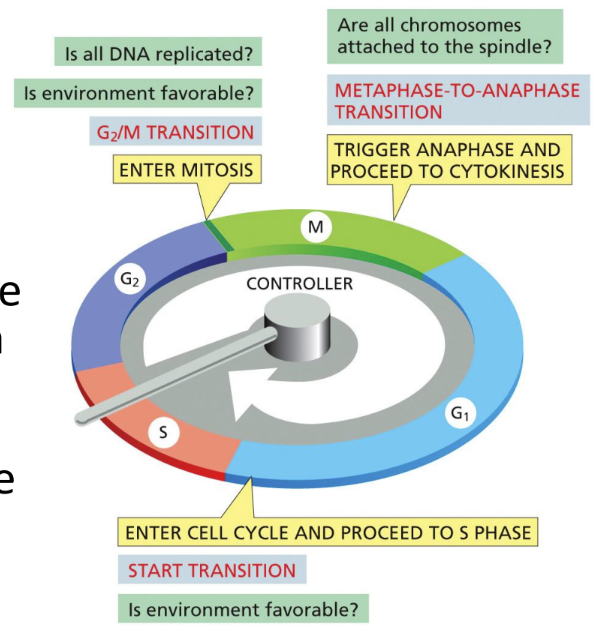
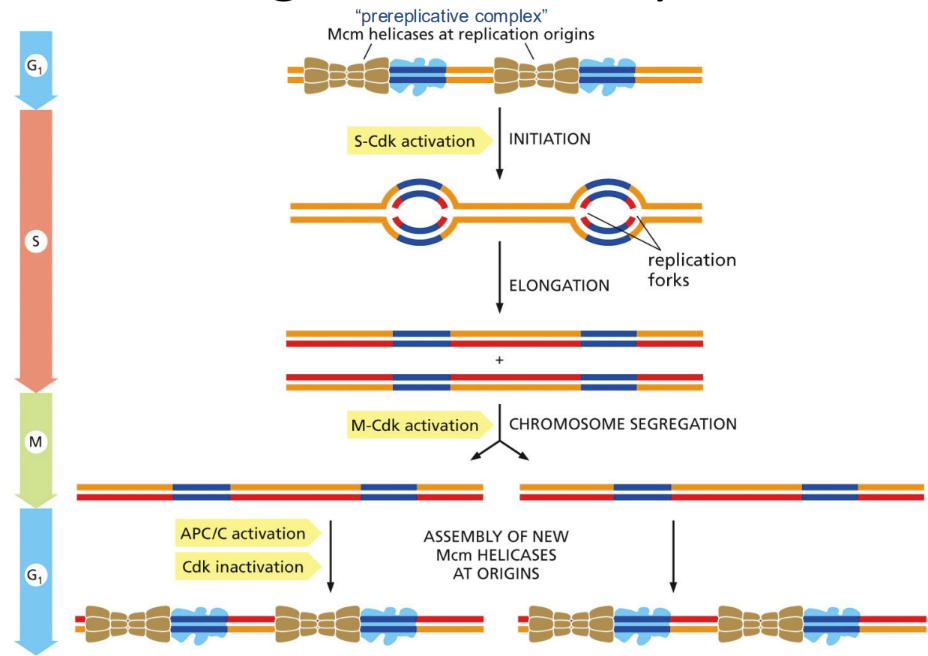
What are the stages of replication during the different steps of the cell cycle (DON’T LOOK AT THE IMAGE RN)
look at the image
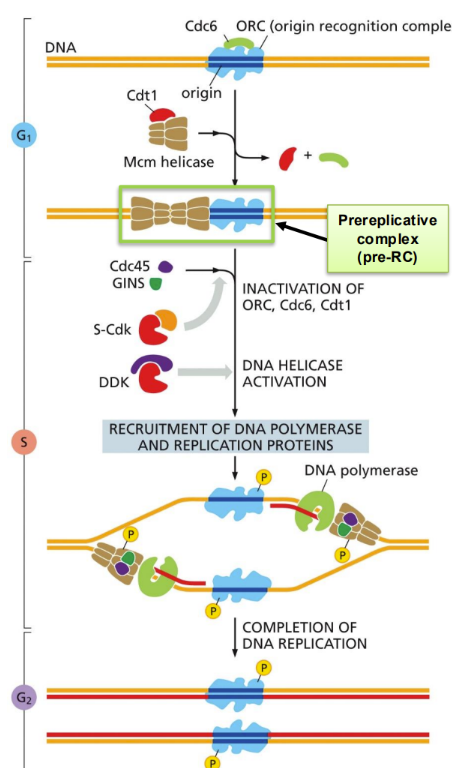
What are cyclins
Cyclins = proteins that activate the Cdks (to do their thing)
Activated by specific cues
Like cell size & intra/extracellular signals (growth factors/hormones)
Four classes = defined by the stage of the cell cycle at which they bind Cdks and function
G1/S-cyclins (E) =
S-cyclins (A) =
M-cyclins (B) =
G1 cyclins (D) =
What are the 4 cyclin types
Four classes = defined by the stage of the cell cycle at which they bind Cdks and function
G1/S-cyclins (E) = activate Cdks in late G1 to trigger progression through the restriction point (commits to entry into cell cycle)
S-cyclins (A) = bind Cdks to help stimulate chromosome replication and control early mitosis
M-cyclins (B) = activate Cdks that stimulate entry into mitosis
G1 cyclins (D) = govern activities of G1/S cyclins
What are Cdks
Cyclin-dependent kinases = protein enzymes that add phosphates to various proteins involved in cell cycling
Phosphorylate things
Activity is regulated by its association with cyclins, activating & inhibitory phosphorylations, and binding of Cdk inhibitors
Distinct pairs of cyclins and Cdks regulate progression through different stages of the cell cycle
Inhibitory mechanisms provide information about the extra- & intracellular environment
Cyclin-Cdk complexes are at the core of the control system
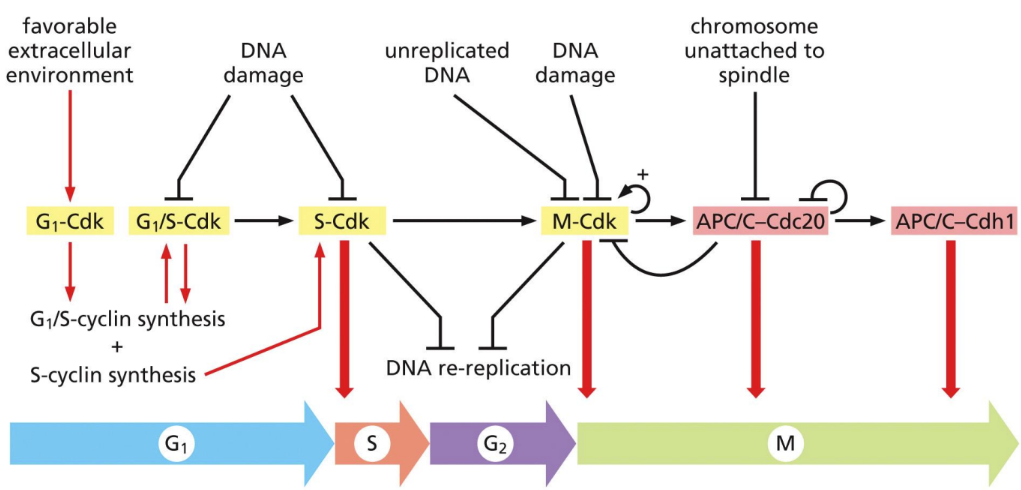
What are the steps of replication initiation
During late mitosis and early G1, prereplication complex (pre-RC) assembles by ORCs (licensing)
M-cdk inhibits this step THEREFORE it occurs when cyclin M and Cdk1 is low
APC/C stimulates this step THEREFORE it happens when APC is high
G1/S complex with high cyclin G1
At onset of S phase, pre-RCs induce formation of preinitiation complex which unwinds the DNA helix and loads DNA polymerase
S-Cdk is activated and triggers preinitiation complex
Elevated S-Cdk keeps step 1 from happing again (until early G1)
What is the pre-replication complex
Pre-replication complex = ORC + origin sequences on dsDNA + helicase + helicase loaders
Works because of low S-phase
S-Cdk presence and deconstruction of pre-RC bring on the pre-initiation complexes and phosphorylation of ORC (begin S phase)
Cdc6 and Cdt1 = helicase loading proteins
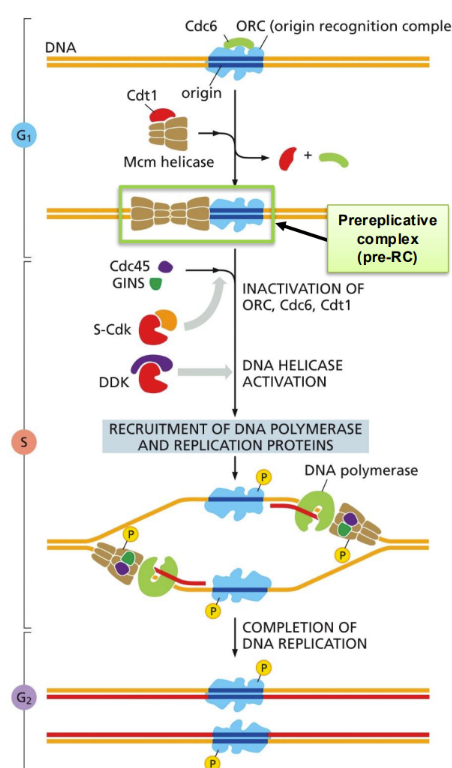
What is the relationship between cyclin and Cdks during the cell cycle
look at image
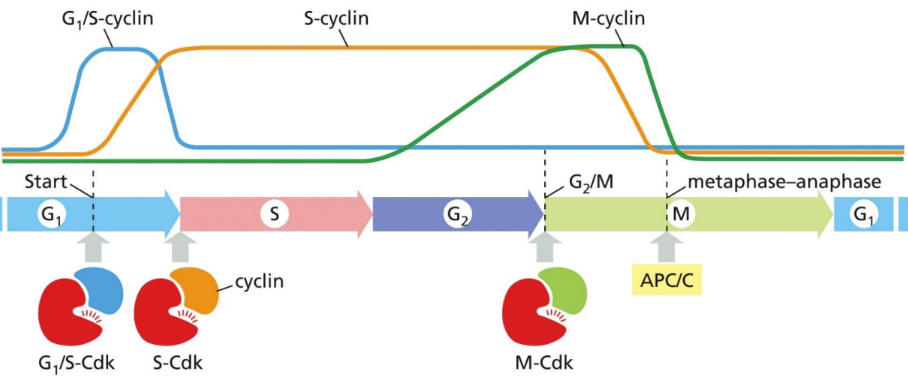
What are the 5 stages of the M phase (described)
Prophase = the two DNA molecules are disentangled and condensed into sister chromatids, which remain linked by cohesion
Prometaphase = starts abruptly with the breakdown of the nuclear envelope. Chromosomes can now attach to spindle microtubules via kinetochores and undergo active movement
Nuclear evelope breakdown = must occur for sister chromatids to attach to spindle
Complex, multistep process
M-Cdk phosphorylates several subunits of nuclear pore complexes
Initiation of pore complex disassembly
Initiation of nuclear lamina (intermediate filament lamin) dissociation
Envelope broken into small vesicles
Metaphase = Sister chromatids are attached to opposite poles of the spindle and align at the spindle equator in a stage
Anaphase = segregation of chromosomes (2 independent yet overlapping processes)
The destruction of sister-chromatid cohesion at the start of anaphase separates the sister chromatids, which are pulled to opposite poles of the spindle
Anaphase A = initial poleward movement of chromosomes
Anaphase B = separation of spindle poles
Telophase = 2 sets of chromosomes are packaged into daughter nuclei
The spindle is disassembled, and the segregated chromosomes are packaged into separate nuclei
Disassembly of the mitotic spindle
Re-formation of nuclear envelope by coalescing around chromosome clusters and re-formation of pore complexes (help from ER)
Contractile ring formation
Lots of dephosphorylation moves process backward
What are the 2 phases in anaphase
Anaphase = segregation of chromosomes (2 independent yet overlapping processes)
The destruction of sister-chromatid cohesion at the start of anaphase separates the sister chromatids, which are pulled to opposite poles of the spindle
Anaphase A = initial poleward movement of chromosomes
Anaphase B = separation of spindle poles

What is cytokinesis
Cytokinesis = cleaves the cell in two, so that each daughter cell inherits one of the two nuclei
Chromatid separation = metaphase-to-anaphase transition initiated by APC
Cohesins disrupted by APC via securin and activated separase, allowing chromatids to separate
APC activation unclear
S- and M-cyclins are destroyed and Cdks are inactived
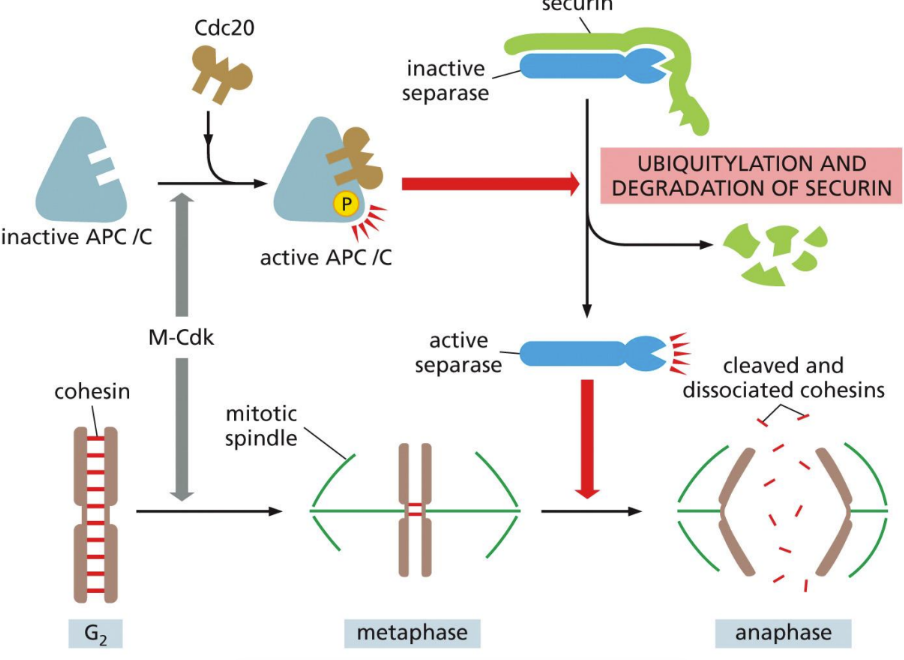
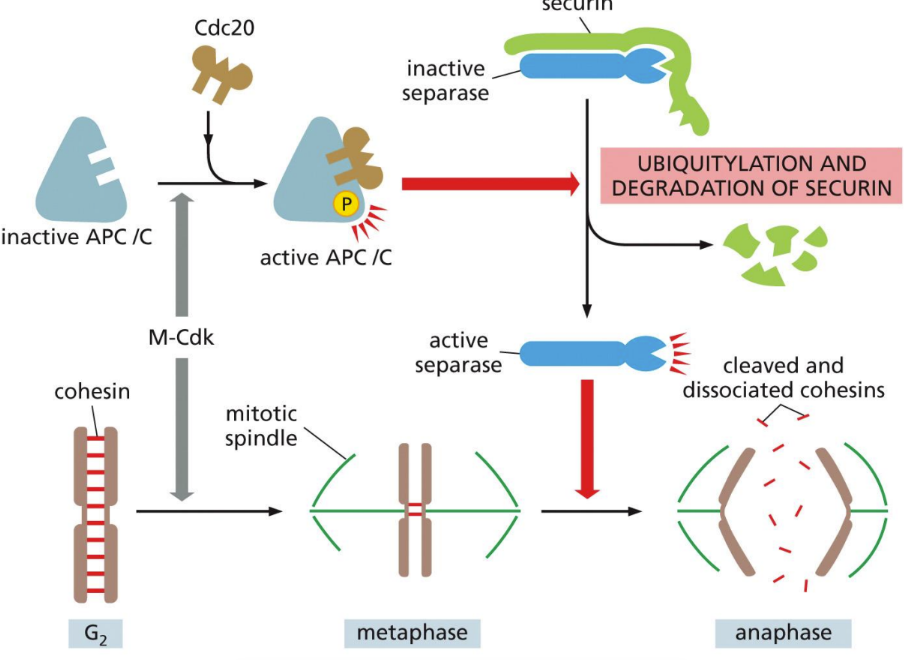
Describe the image
The activation of APC/C by Cdc20 leads to the ubiquitylation and destruction of securin, which normally holds separase in an inactive state. The destruction of securin allows separase to cleave Scc1, a subunit of the cohesin complex holding the sister chromatids together. The pulling forces of the mitotic spindle then pull the sister chromatids apart. In animal cells, phosphorylation by Cdks also inhibits separase. Thus Cdk inactivation in anaphase (resulting from cyclin destruction) also promotes separase activation by allowing its dephosphorylation.
What is M-Cdk in spindle formation
M-Cdk = spindle formation
One single protein kinase complex, M-Cdk, controls all of the occurrences in early stages of mitosis
Cdk1 & cyclin M = M-Cdk
M-cdk phosphorylates key proteins
Induces assembly of mitotic spindle in prophase
Ensures sister chromatids are attached to opposite poles
Triggers chromosome condensation (reorganization of intertwined sisters)
Promotes breakdown of nuclear envelope
Rearranges actin cytoskeleton
How does mitotic spindle formation occur
Mitotic spindle formation
Mitotic spindle formed in centromeres
Minus end of tubule is in the centrosome
Plus end extends away from the centrosome
Poles of spindles are within the centrosome
How do motor proteins relate to MT (D/K)
Motor proteins important
Dynein walks toward the negative end of the microtubule
Kinesin walks towards the positive end of the microtubule
What is mitosis? how is it different from meiosis
Mitosis = homologous chromosomes behave independently of each other (don’t line up together)
Only 1 round of anaphase and cytokinesis
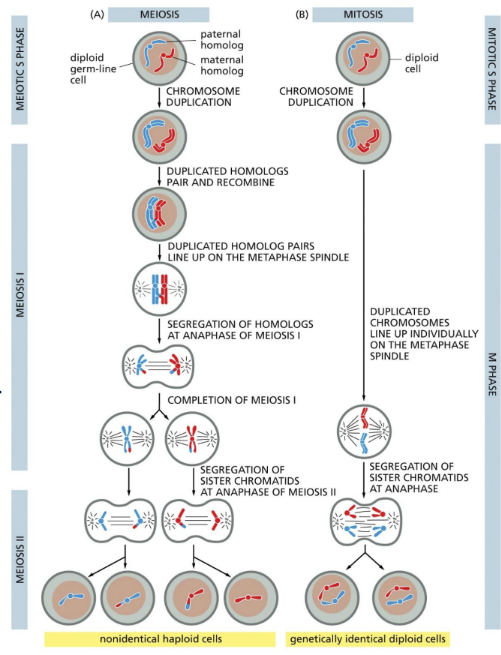
What is meiosis
Meiosis = chromosome duplication is followed by 2 rounds of chromosome segregation
Very important
DNA breaks are formed in each sister so they hold on to each other (crossover) = Homologous recombination
Critical for homologs to recognize each other and come together for meiosis I
Homologos tightly connected and form chiasma (crosses)
Crossing over is the basis of HR
2 rounds of anaphase and cytokinesis
